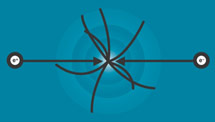
Handy Links
SLAC News Center
SLAC Today
- Subscribe
- Archives: Feb 2006-May 20, 2011
- Archives: May 23, 2011 and later
- Submit Feedback or Story Ideas
- About SLAC Today
SLAC News
Lab News
- Interactions
- Lightsources.org
- ILC NewsLine
- Int'l Science Grid This Week
- Fermilab Today
- Berkeley Lab News
- @brookhaven TODAY
- DOE Pulse
- CERN Courier
- DESY inForm
- US / LHC
SLAC Links
- Emergency
- Safety
- Policy Repository
- Site Entry Form

- Site Maps
- M & O Review
- Computing Status & Calendar
- SLAC Colloquium
- SLACspeak
- SLACspace
- SLAC Logo
- Café Menu
- Flea Market
- Web E-mail
- Marguerite Shuttle
- Discount Commuter Passes
-
Award Reporting Form
- SPIRES
- SciDoc
- Activity Groups
- Library
Stanford
Around the Bay
ILC Update: Detector and Accelerator Reviews

More than 200 scientists gathered in Tsukuba, Japan, last month for TILC09, a joint physics and detector workshop and design meeting for the proposed International Linear Collider. Nearly 10 percent of attendees had SLAC name badges. The lab was well represented in two key review bodies operating at the April 17-21 conference, and will continue to play a strong role in ongoing design and review activities.
"SLAC has been a major player in the ILC's design from the beginning," said Tor Raubenheimer, the assistant director for SLAC's Accelerator Research Division.
At TILC, Raubenheimer and SLAC physicists Jonathan Dorfan and Tom Himel participated in an 11-member Accelerator Advisory Panel, which carried out an in-depth technical review of ILC design and management. The AAP will report its findings and recommendations, which are advisory rather than binding, this weekend at a May 9–10 meeting in Vancouver.
In Tsukuba, another panel, the International Detector Advisory Group, began evaluating design concepts for the ILC's particle detector. IDAG's 16 members include SLAC scientists JoAnne Hewett and Tom Himel. IDAG is looking at three different proposals: the International Large Detector, the Fourth Concept Detector and the Silicon Detector, or SiD, for which SLAC has played a major design role. IDAG is evaluating the feasibility of each proposed design.
"They're trying to decide, ‘Is this concept doable? Is it credible?'" said SLAC physicist John Jaros, who is one of the SiD design's study coordinators. "They'll put a validation stamp on between zero and three of these concepts."
That determination will come at a September meeting in Albuquerque. Jaros is optimistic about SiD's chances, but he said there's a lot of work left to do.
"We were well-received by the IDAG group," he said. "But right now we're very busy preparing answers to the questions they raised. And we're also getting detector R&D going, to establish proof of principle for the SiD detector technologies."
TILC09 was sponsored by the Asian Committee for Future Accelerators. It was the eleventh major meeting of the ILC's Global Design Effort, which hopes to produce a viable, working blueprint for the collider by 2012. Its planners see the ILC as a key complement to the Large Hadron Collider, the largest and highest-energy particle accelerator in the world. The ILC, a positron-electron collider, would help analyze some of the particles discovered at the LHC, which smashes protons together.
The ILC is slated to be about 30 kilometers long, with collision energies of 500 billion electronvolts, with future upgrades to 51 kilometers and one trillion electronvolts possible. The world's longest current linear accelerator, SLAC's linac, is three kilometers long and generates collision energies of about 50 billion electronvolts.
At the moment, however, the ILC remains a proposal on the drawing board. It has no host nation yet, and firm funding remains elusive—a significant problem for a project with a multi-billion-dollar price tag. In fiscal year 2008, support in the United States and the United Kingdom was cut back substantially. But the U.S. has restored funding this year, and Raubenheimer said TILC09 also provided reason for optimism.
"A lot of progress was made in dealing with the details," he said. "People are beginning to re-engage in the project. We have the momentum to push the design through and implement [the overall plan] in 2012, which will be an important milestone."
—Michael Wall
SLAC Today, May 7, 2009